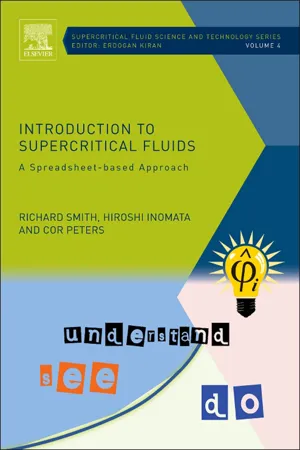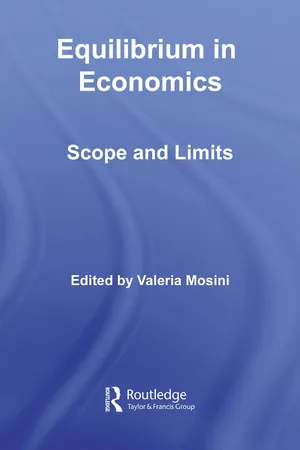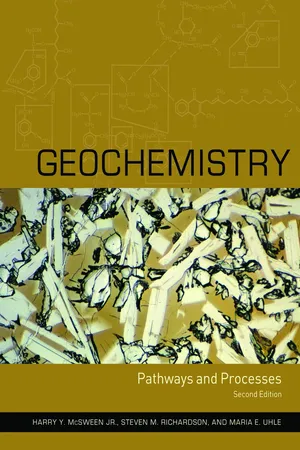Chemistry
Le Chatelier's Principle
Le Chatelier's Principle states that when a system at equilibrium is disturbed by a change in temperature, pressure, or concentration of reactants or products, the system will adjust to counteract the change and restore equilibrium. This principle helps predict how a system will respond to changes and is fundamental in understanding chemical reactions and equilibrium.
Written by Perlego with AI-assistance
Related key terms
Related key terms
1 of 4
Related key terms
1 of 3
4 Key excerpts on "Le Chatelier's Principle"
- eBook - ePub
- Jeffrey Gaffney, Nancy Marley(Authors)
- 2017(Publication Date)
- Elsevier(Publisher)
This is known as Le Chatelier's Principle, after the nineteenth century chemist Henry-Louis Le Chatelier, who studied the effects of changes in reaction conditions on a chemical equilibrium. The exact statement of Le Chatelier's Principle is; • When a chemical reaction at equilibrium is subjected to a change in reaction conditions, the position of the equilibrium will shift to counteract the effect of the change until a new equilibrium is established. The ways that a chemical reaction at equilibrium will respond when disturbed by a change in the original conditions can be predicted. These predicted responses and their effects on the equilibrium constant are summarized in Table 7.1 for each of the changing conditions. If the concentration of a reactant or product in a reversible chemical reaction at equilibrium is changed, by the addition or the removal of either a reactant or a product, the equilibrium will be reestablished by adjusting the concentrations of reactants and products so that their ratio and the value of K eq will remain the same. For example, if the concentration of reactant A in the generic Eq. (3) of Section 7.1 is increased by the addition of A to the reaction system, the reaction will shift to consume the added reactant A and form more of the products C and D. This increases the value of the numerator of K eq and decreases the value of the denominator compensating for the increase in the value of the denominator caused by the added reactant. This response can be useful in an industrial process if it is necessary to convert the maximum possible amount of reactant B into the products C and D when reactant B is an expensive or rare material and reactant A is inexpensive and abundant. In this case, the addition of excess reactant A becomes a means of conserving the more expensive reactant B while producing as much product as possible - eBook - ePub
Introduction to Supercritical Fluids
A Spreadsheet-based Approach
- Richard Smith, Hiroshi Inomata, Cor Peters(Authors)
- 2013(Publication Date)
- Elsevier Science(Publisher)
φ that are greater than one cause a decrease in product formation. Le Châtelier's principle was used to estimate the probable effects of pressure, presence of an inert ideal gas, and presence of a supercritical fluid on the chemical equilibria. The effects described by Le Châtelier's principle are those for perfect chemical equilibrium and because of this, they cannot account for a number of effects such as how the kinetics, adsorption, mass transfer, or phase behavior change according to reaction conditions. Kinetics or phase behavior may be dominant and lead to enhanced or inhibited effects on a reaction according to temperature, pressure or other variables of a system.It is helpful to analyze the chemical equilibria of reactions in supercritical fluids to understand some of the effects of a non-ideal reaction environment and the limitations of chemical transformations. Some of the common analyses are:• examination of chemical equilibria at constant pressure conditions over a range of temperatures to study trends in the possible conversions and selectivities • examination of chemical equilibria at constant temperature conditions over a range of pressures to study trends in possible conversions and selectivities• examination of the reaction under adiabatic (Q = 0) conditions to determine heating or cooling requirementsFor all of these conditions, the chemical reaction proceeds from a molar extent of reaction value of X = 0 to a value of X = X eq , which is the value at chemical equilibrium. By knowing the equilibrium value, other calculations can be made that can provide insight into appropriate reactor conditions or mixing considerations.Objective 3: to Show the Effect of Nonidealities on “Real-World” Chemical EquilibriaThe effect of temperature on a reaction is usually dominant over other variables such as pressure and phase nonidealities. For gas-phase reactions, the effect of nonidealities on chemical equilibria is small. For supercritical-phase reactions, such as hydroformylations, the effects are larger. The fugacity coefficients of the reaction species and the trend of K φ - eBook - ePub
- Valeria Mosini(Author)
- 2008(Publication Date)
- Routledge(Publisher)
And since quadratic forms of this type are intimately involved in economic maximising problems, it is not surprising that the Le Chatelier principle should have found many applications in theoretical economics’ (Samuelson 1960b, p. 368). 20 In the same paper, Samuelson stated that the mathematical isomorphism between thermodynamics and mathematical economics creates an analogy between the two disciplines that would not be challenged even by the possible failure to find analogies between the parameters – which reflect the properties of the entities – that appear in the theories (Samuelson 1960b). As this, and other, similar, considerations suggest, Samuelson was reasoning about ‘abstract’ mathematical analogies, 21 thereby showing that the Le Chatelier–Samuelson principle was born out of the deductive methodology. Conclusion We wish to conclude by pointing out some common aspects between the epistemologies underlying the two concepts of equilibrium outlined here. Lavoisier and Le Chatelier were concerned, one might say obsessed, with rationalisation. Ratio means rapport, quantification, mathematisation. Both men had a deep faith in mathematics, and used the concept of equilibrium to quantify chemical reactions. Lavoisier’s all-pervasive balance method relied on the assumption that matter is conserved, an assumption that provided him with a means of universal commensurability. On his account, all sorts of phenomena – oxidation, the work of an artist, the growth of a plant – could be compared by means of weighing. Even an imponderable substance such as caloric could be ‘weighed’, as it were, by the use of a calorimeter. Le Chatelier’s concept of equilibrium was haunted by the acknowledgement of the inevitability of losses in physical processes, sanctioned by the second principle of thermodynamics - eBook - ePub
Geochemistry
Pathways and Processes
- Harry McSween, Steven Richardson, Maria Uhle(Authors)
- 2003(Publication Date)
- Columbia University Press(Publisher)
CHAPTER NINE TEMPERATURE AND PRESSURE CHANGES Thermodynamics Again OVERVIEWThis chapter expands on the thermodynamic principles introduced in chapter 3 and provides the preparation for the next chapter on phase diagrams. We first give a thermodynamic definition for equilibrium. We also derive the phase rule and explore its use as a test for equilibrium. The effects of changing temperature and pressure on the free energy of a system at equilibrium are analyzed, and a general equation for dḠ at P and T is formulated. P-T and Ḡ -T diagrams for one-component systems are introduced. The utility of the Clapeyron equation in constructing or interpreting phase diagrams is explored. We then introduce concepts that are necessary for understanding systems with more than one component. Raoult’s law and Henry’s law are defined, and expressions for the chemical potentials of components that obey these laws are derived. The concept of standard states is introduced, and we examine how activity coefficients are defined in mixing models. The usefulness of these concepts is illustrated by discussing formulation of a geothermometer and a geobarometer.WHAT DOES EQUILIBRIUM REALLY MEAN?In previous chapters, we have introduced and made use of the concept of thermodynamic equilibrium. By this time, you should be comfortable with the idea that the observable properties of a system at equilibrium will undergo no change with time, as long as physical conditions imposed on the system remain constant. Although this statement is commonly used to define equilibrium, it is actually a consequence of equilibrium rather than a strict definition of it. A more rigorous definition of the equilibrium state that we have not seen before is: a condition of minimum energy for that portion of the universe under consideration.We have also learned that Gibbs free energy is a convenient way of describing the energy of a system. The relationship of this thermodynamic quantity to temperature, pressure, and the amounts of the constituent components of a system is given by the following:
Index pages curate the most relevant extracts from our library of academic textbooks. They’ve been created using an in-house natural language model (NLM), each adding context and meaning to key research topics.
Explore more topic indexes
Explore more topic indexes
1 of 6
Explore more topic indexes
1 of 4



